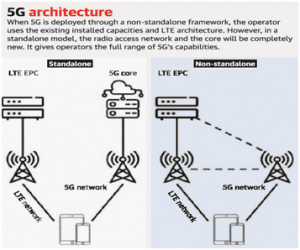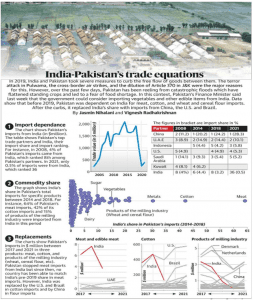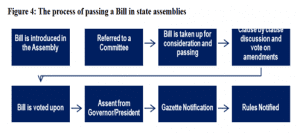DAILY CURRENT AFFAIRS (SEPTEMBER 05, 2022)
THE ECONOMIC DEVELOPMENT
1. INDIA BECOMES WORLD’S FIFTH-LARGEST ECONOMY
THE CONTEXT: Recently, India has overtaken the UK to become the fifth largest economy in the world. India is now behind the US, China, Japan and Germany in terms of economy.
THE EXPLANATION:
• According to figures from the International Monetary Fund (IMF), India passed the United Kingdom (UK) to become the fifth-largest economy in the world in the last quarter of 2021. India’s economy currently ranks just four nations ahead of it in terms of size in dollars. The United States, China, Japan, and Germany are the only nations with economies larger than India’s. The UK is currently in sixth place, just behind India.
• The report highlighted that in purchasing power parity (PPP) terms, India’s GDP (PPP) is $ 10.51 trillion, exceeding that of Japan and Germany. Due to India’s high population, India’s GDP per capita is $ 2,170 (for comparison, the US is $ 62,794).
• India’s real GDP growth, however, it said is expected to weaken for the third straight year from 7.5 per cent to 5 per cent.
• The report observed that India’s economic liberalisation began in the early 1990s and included industrial deregulation, reduced controls on foreign trade and investment, and privatisation of state-owned enterprises. These measures have helped India accelerate economic growth.
• India’s service sector is the fast-growing sector in the world accounting for 60 per cent of the economy and 28 per of employment, the report said, adding that manufacturing and agriculture are two other significant sectors of the economy.
• The US-based World Population Review is an independent organisation without any political affiliations.
What is PPP?
• Purchasing power parity (PPP) is a popular metric used by macroeconomic analysts.
• It compares economic productivity and standards of living between countries.
• In some countries adjust their gross domestic product (GDP) figures to reflect PPP.
Way ahead:
• The pace of the economic recovery will be indistinguishably linked to the development of the Covid-19 pandemic, both domestically and internationally.
• As the manufacturer of the majority of the world’s vaccines and with a 42-year-old vaccination programme (Universal Immunisation Programme) that targets 55 million people each year, India is better placed than many other developing countries to roll out the vaccines successfully and efficiently next year.
• In the medium to long term, reforms such as the 2016 demonetisation and more recently the controversial efforts to liberalise the agricultural sector can deliver economic benefits.
• However, with the majority of the Indian workforce employed in the agricultural sector, the reform process requires a delicate and gradual approach that balances the need for longer-term efficiency gains with the need to support incomes in the short-term.
• The infrastructure bottlenecks that exist in India mean that investment in this area has the potential to unlock significant productivity gains.
• Therefore, the outlook for the economy going forwards will be closely related to the government’s approach to infrastructure spending.
2. IMF $2.9BN DEAL TO AID SRI LANKA
THE CONTEXT: Recently, the International Monetary Fund (IMF) has come forward to help Sri Lanka, which is facing a historic economic crisis. The IMF has announced a loan of $ 2.9 billion to Sri Lanka.
THE EXPLANATION:
• The aid aims to restore macroeconomic stability and creditworthiness in Sri Lanka as well as protect financial stability.
• The IMF and Sri Lankan authorities have agreed on a 48-month loan under the Extended Funds Facility (EFF) of about $2.9 billion to help stabilise the economy and boost growth.
• The agreement between Sri Lanka and the IMF is only preliminary, and has to be approved by the IMF management and its executive board. It will also go through only if Sri Lankan authorities carry out previously agreed measures which include additional funding from multilateral partners and debt relief from Sri Lankan lenders to help ensure debt affordability and bridge the financial gap.
• Starting with one of the lowest revenue levels in the world, this loan program will implement major tax reforms. These reforms include making personal income tax more progressive and expanding the tax base for corporate income tax and VAT.
VALUE ADDITION:
International Monetary Fund (IMF)
• IMF is an international financial institution. It is headquartered in Washington, D.C. The institution comprises of 190 countries. It is working to foster global monetary cooperation, facilitate international trade, secure financial stability, promote sustainable economic growth, promote high employment and reduce poverty worldwide.
• It was created in 1944 but started working formally on December 27, 1945. It came into existence with 29 member countries.
Why was IMF created?
• The IMF was originally created as a part of the Bretton Woods system in 1944. During the Great Depression, countries raised the barriers to trade in order to improve their failing economies.
• This resulted into devaluation of national currencies and decline in world trade. Breakdown in international monetary cooperation created a need for oversight. Thus, representatives of 45 governments met at the Bretton Woods Conference, in the United States, to discuss a framework for an international economic cooperation and to rebuild Europe.
3. ADDITIONAL SAFETY REQUIREMENTS IN BATTERY STANDARDS
THE CONTEXT: In April 2022, the cases of fire in electric two-wheelers of manufacturers such as Ola Electric, Okinawa Autotech and PureEV were reported. Following which the government constituted an expert committee under the chairmanship of Tata Narasimha Rao (Director, ARC, Hyderabad) to probe it.
THE EXPLANATION:
• The committee submitted its recommendation to the government recently. These new safety standards will come into effect from 1 October 2022. Ministry has also sought comments and suggestions from all stakeholders within a period of thirty days.
• These new rules will be applicable to electric two-, three- and four-wheelers, passenger and goods vehicles. These modifications included specific requirements for L-class motor vehicles with electric power trains (engines) and requirements for M-class and N-class motor vehicles for electric power trains.
• Whereas, L class motor vehicles are those which have less than four wheels, whereas M category vehicles are those which have at least four wheels and are used for transporting passengers.
• These modifications include additional safety requirements relating to thermal diffusion due to fire from the battery cell, on-board charger, the design of the battery pack, and internal cell short circuits.
Mandatory to include ‘Safety Fuse’
• In this new amendment it has been made mandatory to include ‘Safety Fuse’. This will blow the battery off the powertrain and immediately disconnect it in case of excessive heat generation or high current outflow.
EVs will now also have four additional sensors
• These sensors will help to quickly identify the problem if there is a problem with the battery system. These sensors will show an error on the console of the vehicle which will alert the driver to take necessary corrective or remedial measures.
Distance between two battery cells is compulsory
• It is also said to increase the distance between two battery cells used in electric vehicle batteries. It is recommended by the panel to help release heat in the event of thermal runaway in rechargeable energy storage systems (RESS) and to help detach cells.
Auto cut-off feature for charger
• Electric vehicle chargers will be redesigned to include a charge voltage cut-off as well as a time-based charge cut-off function. This will help prevent overcharging the RES.
Audio-visual alerts for drivers
• The EVs will have to be equipped with audio-visual alerts for early detection of thermal events or gases in case of thermal runaway of the cell.
THE GOVERNMENT SCHEMES IN NEWS
4. SCHEME FOR ‘PROMOTION OF BULK DRUG PARKS’
THE CONTEXT: The Department of Pharmaceuticals has recently given ‘in-principle’ approval to the proposals to set up bulk drug parks in three states- Himachal Pradesh, Gujarat and Andhra Pradesh under the scheme of “Promotion of Bulk Drug Parks”. This is a major initiative to support bulk drug manufacturing in the country.
THE EXPLANATION:
• Under this scheme, proposals for construction of bulk drug parks were received from 13 states. Out of which Himachal Pradesh, Gujarat and Andhra Pradesh have been selected.
• The financial assistance for the proposed bulk drug parks in Gujarat and Andhra Pradesh will be 70 per cent of the project cost of the shared infrastructure.
• At the same time, being a hill state, the financial assistance for Himachal Pradesh will be 90 percent of the total project cost. The maximum assistance for wholesale drug parks under this scheme will be limited to Rs 1,000 crore.
About the Parks
These parks will be set up on 1402.44 acres in Haroli tehsil of Una district of Himachal Pradesh, 2015.02 acres in Jambusar tehsil of Bharuch district of Gujarat and 2000.45 acres at KP Puram and Kodhaha in Thondangi mandal of East Godavari district.
Project Benefits
• The bulk drug parks to be developed under this scheme will provide common infrastructure facilities at one place, thereby creating a strong ecosystem for bulk drug manufacturing in the country and will also bring down the manufacturing cost significantly.
• The scheme is expected to gain a foothold in the global market by encouraging domestic manufacturing of bulk drugs and providing easy access to standard testing and infrastructure to reduce import dependence.
• The scheme will help the industry to meet environmental standards at low cost through innovative methods of common waste management system and to reap the benefits arising out of the optimization of resources and economies of scale.
THE SCIENCE AND TECHNOLOGY
5. DEPLOYING 5G IN A WORLD BUILT ON 4G TECHNOLOGY
THE CONTEXT: According to Statista data, the total number of smartphone users in the world has nearly doubled from 3.7 billion in 2016 to 6.6 billion in 2022.Since 4G’s inception in the early 2010s, the number of smartphone users have grown significantly.
THE EXPLANATION:
• A 5G-based connected future is upon us. That means deploying services in a world filled with 4G compatible devices. So, telecom operators have two options. They can either build a non-standalone (NSA) or a standalone architecture.
• Since the dawn of mobile communication in the early 1980s, companies and consumers have been adapting to new ways of sending and receiving information. The first-generation technology of this era let people make and receive phones calls through their mobile handheld devices while the second and third generations added text and multi-media messaging, as well as email services to cell phones. The emergence of 4G in the early part of the past decade changed the mobile-telephone landscape. This paradigmatic shift let users stream and download videos at speeds three times greater than 3G. The Long Term Evolution (LTE) standard-based generation had two important characteristics it apart from its predecessors.
What is 5G technology?
• 5G is a fifth-generation wireless communication technology that has very high reliability, spectrum bands and speed which is around 10 plus Gbps (20 times that of 4G).
• It is based on the IEEE 802.11ac standard of broadband connectivity. But a formal standard has not been set yet.
• The final standard for 5G will be established by the International Telecommunications Union (ITU).
Different Bands of 5G
5G primarily operates across three bands: low, mid, and high-frequency spectrums, each with its own set of benefits and drawbacks.
• Low Band Spectrum: The maximum speed of Internet and data exchange is limited to 100 Mbps in terms of coverage and speed (Megabits per second). This means that telecom companies can use and install it for commercial cellphone users who may not have specific demands for very high-speed Internet. However, the low band spectrum may not be optimal for specialised needs of the industry.
coverage and speed (Megabits per second). This means that telecom companies can use and install it for commercial cellphone users who may not have specific demands for very high-speed Internet. However, the low band spectrum may not be optimal for specialised needs of the industry.
• Mid-Band Spectrum: It has faster speeds than the low-band spectrum, but it has restrictions in terms of coverage area and signal penetration. This band could be utilised by industries and specialised production units to create captive networks that can be tailored to their specific demands.
• High Band Spectrum: It has the fastest speed of all three bands, but its coverage and signal penetration intensity are severely limited. This band significantly improves future 5G technology applications such as the Internet of Things (IoT) and smart technologies, although it has significant infrastructure requirements.
Advantages/Applications of 5G technology
• With very high speed, 5G allows access to high-bandwidth multimedia such as HD videos, movies and games which can be downloaded in seconds.
• It enables high-speed data services that have industrial applications.
• It supports critical applications like financial transactions and healthcare.
• It will help incorporate Artificial Intelligence (AI) in our daily lives. It will enable cloud systems to stream software updates, music and navigation data to driverless cars seamlessly. It will also facilitate vehicle-vehicle communications in order to keep a safe distance from each other = fewer car accidents + less traffic congestion.
Disadvantages of 5G technology
• Technology is still in progress and research on its viability is going on.
• The speed on such scale (10,000 Mbps) is difficult to achieve considering the incompetent technological support in most parts of the world.
• Many of the old devices would not support 5G. Therefore all of them need to be replaced with new ones.
• Developing infrastructure for 5G is expensive.
India’s Initiatives
• Bharatnet project was launched in 2017 for providing digital infrastructure on a non-discriminatory basis by affordable broadband connectivity for all households. The objective is to facilitate the delivery of e-health, e-governance, e-banking, e-education, Internet and other services to rural areas.
• National Optical Fibre Network (NOFN) aims at bringing a broadband revolution in rural areas. Its objective is to connect all the Gram Panchayats in the country with 100 Mbps connectivity. As we have seen earlier, fibre provides strong backhaul, thus facilitates the adoption of 5G.
• High-level forum to develop 5G roadmap – Recently, the Department of Telecommunications set up a high-level forum to evaluate roadmaps and create a strategy to adopt 5G in the country by 2020.
• Waivers for Private telecoms -The government also announced a subsidy of Rs 3,600 crore to private telecom players such as Bharti Airtel, Vodafone India, and Reliance Jio to establish Wi-Fi in rural areas as part of the second phase of the BharatNet project.
THE SECURITY AFFAIRS
6. TEJAS MARK-2 PROJECT
THE CONTEXT: Recently the Cabinet Committee on Security (CCS) approved the project to develop a more capable and powerful version of the indigenous aircraft LCA Mark 2 multirole fighter jet.
THE EXPLANATION:
• The Tejas Mark-2 is described as a 4.5-generation machine, which will not only have 70 per cent indigenization (as opposed to the Mark IA’s 62 per cent), but will incorporate more advanced technologies to be manufactured in India. Tejas is a single-engine and highly maneuverable multi-role supersonic fighter aircraft manufactured by state-run Hindustan Aeronautics Limited (HAL).
opposed to the Mark IA’s 62 per cent), but will incorporate more advanced technologies to be manufactured in India. Tejas is a single-engine and highly maneuverable multi-role supersonic fighter aircraft manufactured by state-run Hindustan Aeronautics Limited (HAL).
• The jet will be fitted with the more powerful GE-414 engine, which will give it a longer combat range and more weapon-carrying capability than the existing Tejas Mark-1 (GE-404 engine).
• Also, the look of Tejas Mark-2 is of the 21st century. Next to the wings, a canard resembling those of contemporary fighters such as the Rafale, Eurofighter or Sukhoi-30MKI has been added.
• Apart from the weapon payload and engine, the interiors of the Tejas Mark-2 will be rearranged, to make it more accessible and maintenance-friendly.
• The fighter jet will be developed at a cost of over Rs 6,500 crore, in addition to the Rs 2,500 crore approved earlier.
Why is Tejas Mark-2 important?
• The approval of Tejas Mark-2 is a big relief for the Indian Air Force. The IAF currently has 30 fighter squadrons against the sanctioned strength of 42, which is insufficient at a time when the country is facing threats from both China and Pakistan.
• The LCA Mark-2 fighter jets will replace the Jaguar and Mirage 2000 fighters when they are phased out after 10 years. The new Tejas is a very formidable aircraft which will surely add more strength to the IAF list.
THE DATA POINT


